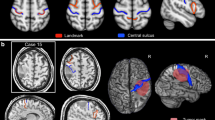Summary.
Summary.
Background:
The authors evaluated the impact of motion artefacts on presurgical mapping of the sensorimotor cortex with functional magnetic resonance imaging (fMRI). Different mapping paradigms were compared with regard to the frequency of motion artefacts and the resulting signal increase.
Method:
94 surgical candidates with mass lesions near the central region were investigated using BOLD1-contrast T2* weighted multislice multi-echo EPI gradient echo sequences on a 1,5 T Philips Gyroscan. Three functional paradigms were performed: a) repetitive self-paced clenching of the hand to a fist (68 runs); b) repetitive finger-to-thumb opposition (46 runs); c) sensory stimulation by repetitive brushing of the palm (15 runs). Task-related haemodynamic changes were identified by statistical analysis with the Kolmogorov-Smirnov-test. MR signal increase in percent was calculated for each of the paradigms. Motion artefacts were rated on a scale from 1 to 3.
Findings:
Severe motion artefacts occurred in 8 hand clenching runs and in 2 finger opposition runs. Artefacts were more pronounced in hand clenching than in finger opposition. There were no motion artefacts in any of the sensory stimulation runs. Concerning the percent MR signal change there was no significant difference between hand clenching and finger opposition (T-test: p>0,5) but a highly significant difference (p<0,0001) between both motor tasks and the sensory paradigm (hand clenching: 2.68±0.75; finger opposition: 2.76±0.79; sensory stimulation: 1.72±0.65).
Interpretation:
Sensory stimulation causes by far less artefacts than motor paradigms but it also has to be considered less sensitive as it produces a smaller MR signal increase. Therefore in presurgical evaluation sensory stimulation should be kept in reserve for cases in whom motion artefacts are very likely to occur, i.e. patients with severe forms of paresis.
Similar content being viewed by others
Author information
Authors and Affiliations
Rights and permissions
About this article
Cite this article
Hoeller, M., Krings, T., Reinges, M. et al. Movement Artefacts and MR BOLD Signal Increase During Different Paradigms for Mapping the Sensorimotor Cortex. Acta Neurochir (Wien) 144, 279–284 (2002). https://doi.org/10.1007/s007010200036
Issue Date:
DOI: https://doi.org/10.1007/s007010200036




